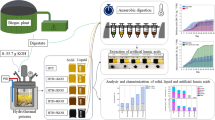Abstract
Microcalorimetry can be used as a tool for the analysis of microbial growth on soluble or insoluble substrates. Modern apparatus allows studies under aerobic or anaerobic growth culture conditions. The heat quantity evolved during any microbial growth is dependent on catabolic and anabolic reactions according to:△H met=(1-α)△H cat+α△H an
In this relationship, δHmet, δHcat, and δHan are the enthalpy variations associated with metabolic, catabolic, and anabolic reactions, respectively, and a represents the molar fraction of the energy source that is incorporated into cellular carbon.
The value of α is strongly influenced by culture conditions. Under anaerobic conditions, the α coefficient is low and does not exceed 0.2. Under aerobic conditions, α can reach a value as high as 0.6. Some experimental results were presented and discussed.
Modern microcalorimeters record the power evolved by microbial growth as a function of time. The curves obtained are called power-time curves. These curves can be used for the determination of growth parameters. However, power-time curves allow visualization of some catabolic phenomena that are not related to growth because they occur during the stationary growth phase. Some examples were shown.
More recently, microcalorimetry has been used for studies of degradation of insoluble substrates, such as lignocellulosic compounds, by pure or mixed cultures of microbes. The results obtained with pure cultures of bacteria growing on cellulose were interpreted using the same relationships that have been used for studies on soluble sugars. It was possible to show the influence of the structure of the cellulose on the kinetics of its degradation. The results obtained with mixed cultures were difficult to interprete at the present time. The power-time
curves are very complex, showing many heat peaks that cannot be related to any known physiological phenomena. However, the total heat evolved during lignocellulosic fermentation by mixed cultures is proportional to the quantity of sugar fermented; this was demonstrated and discussed. Thus it can be concluded that microcalorimetry can be used for the estimation of the biodegradability of any solid substrate. This technique can also be used for evaluation of the efficiency of the pretreatments of lignocellulosic compounds that are done to increase the biodegradability of these substrates. Recent data will be shown.
Similar content being viewed by others
Author information
Authors and Affiliations
Rights and permissions
About this article
Cite this article
Belaich, J.P., Fardeau, M.L. Microcalorimetric study of the biodegradation of cellulolytic compounds. Appl Biochem Biotechnol 9, 329–330 (1984). https://doi.org/10.1007/BF02798960
Issue Date:
DOI: https://doi.org/10.1007/BF02798960




